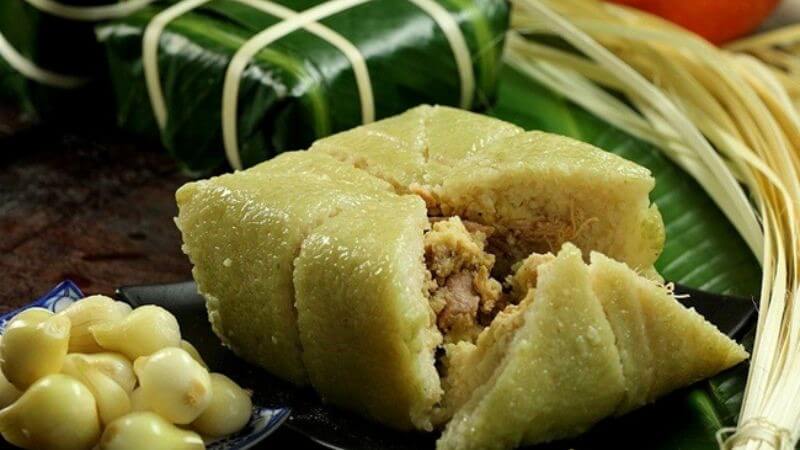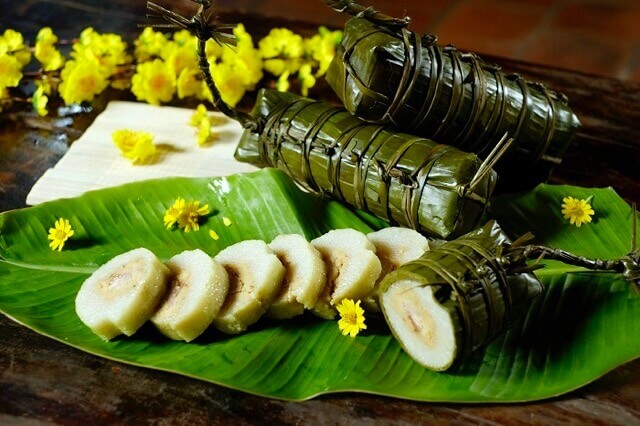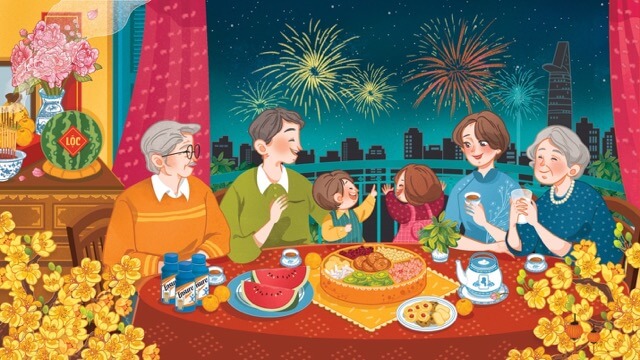Tet, or Vietnamese New Year, is Vietnam’s most important holiday. It is observed at the beginning of the lunar year, which is normally in late January or early February. The event is strongly ingrained in Vietnamese culture, and it is a time for family reunions, feasting, and honoring ancestors.
Tet is also related to a number of ancient practices and beliefs, such as the distribution of auspicious red envelopes and the cooking of special delicacies. In this post, we will look deeper into Tet’s significance in Vietnamese culture and some of its unique customs and traditions.
See more: Vietnam Holiday Delights
Exploring the Rich Traditions of Vietnamese New Year
Tet is a time for remembering ancestors, family reunions, and exchanging new year’s greetings. It is also linked to various distinct traditions stretching back hundreds of years. Cleaning the house and preparing special delicacies are two of the most critical Tet traditions.
Cleaning the house before Tet is believed to sweep away any bad luck from the previous year and make room for good fortune in the coming year.

Unique dishes are created for sharing with family and friends, such as Banh Chung (sticky rice cake), Mut (candied fruits), and Xoi (sticky rice).
Another prominent custom is the distribution of fortunate red envelopes, known as “li xi,” to children, unmarried adults, and the elderly. The money-filled envelopes represent good fortune and wealth for the recipient.

In addition to these customs, many others vary depending on the location of Vietnam. In the north, for example, it is customary to have a “Tet pole” outside the home, decked with red flags and flowers. There is a tradition in the South known as “Tet flowers,” in which people buy flowers to decorate their houses and streets.
These customs are deeply embedded in Vietnamese culture and history and are celebrated yearly during Tet with tremendous passion and delight.
Get to know more about Vietnamese culture: Hung Kings Commemoration Day
Vietnamese New Year Food: Celebrating Tet with Delicious Cuisine
Tet celebrations in Vietnam revolve around food, with families and friends gathering to share traditional meals and enjoy each other’s company. Many Tet dishes have symbolic meanings and are said to bring good luck and wealth in the new year.
Banh Chung is one of the most iconic Tet foods, a sticky rice cake wrapped in banana leaves prepared with glutinous rice, pork belly, and mung beans. The dish signifies the soil and is thought to represent the family’s strength and stability. Pickled onions, or Dua Hanh, are another famous delicacy that is said to fend off evil spirits.

Aside from these foods, several more are popular during Tet, including Xoi (sticky rice), Thit Kho (caramelized pork), and Nem (spring rolls). Many families also make a Tet tray, or “Mam Ngu Qua,” which contains a range of symbolic delicacies such as dried apricots, candied coconut, and watermelon seeds.
Food plays a role in its symbolic implications and sharing and gathering with loved ones. During Tet, families frequently cook enormous feasts and ask friends and neighbors to join them in the festivities. It is also customary to pay visits to family and friends and present culinary gifts, such as Banh Chung, as a sign of respect and well wishes for the following year.
Each region of Vietnam has its own Tet recipes and eating customs. Banh Chung is the most popular Tet food in the north. At the same time, Banh Tet, a similar but thinner variant of the sticky rice cake, is popular in the South.

Others in central Vietnam generally eat a particular noodle soup called Bun Bo Hue. Still, others in the Mekong Delta region consume Canh Chua (sour soup) with fish and vegetables.
Vietnam also has a diverse ethnic population, each with their own Tet food traditions. The Muong ethnic community, for example, enjoys a delicacy called Xoi Day, which is a type of sticky rice with beans, pork, and bamboo shoots. Banh It La Gai is a sweet sticky rice cake wrapped in thorn leaves made by the Cham ethnic group in central Vietnam.
Vietnamese New Year food is a delicious and essential part of Tet celebrations, with traditional dishes that carry deep symbolic meanings and bring families and communities together in joy and unity. From north to South and across different ethnic groups, Tet is an excellent opportunity to explore the diverse culinary traditions of Vietnam.
Another important holiday in Vietnam: International Workers Day .
Happy New Year in Vietnamese: Wishing You a Joyous Tet
Tet is the most important holiday in Vietnamese culture, and it is a time for family reunions, traditional customs, and paying respect to ancestors. It is also a time for exchanging greetings and good wishes for the new year.
If you wish someone a Happy New Year in Vietnamese, you can say, “Chuc Mung Nam Moi!” This phrase is pronounced like “chook moong nahm moy” and is a standard greeting during Tet. Another common phrase is “Tet Hanh Phuc!” which means “Happy Tet!” and is used to wish someone a joyful and prosperous holiday.
In addition to these greetings, many other common phrases and expressions are used during Tet. For example, when giving or receiving lucky red envelopes, it is customary to say “Xin Chuc Mung Nam Moi!” which means “Happy New Year and congratulations!” When visiting friends or relatives, it is polite to say “Tet Vui Ve Nhe!” which means “Enjoy Tet!” or “Have a joyful Tet!”
Sharing new year’s wishes for good health, prosperity, and happiness is also customary. “Suc Khoe Doi Dao!” means “Wishing you good health!” and “Phat Tai!” means “Wishing you prosperity!” are two typical words for this.
Finally, wishing someone a Happy New Year in Vietnamese is an excellent approach to demonstrating your admiration for Vietnamese culture and traditions. May your holiday be filled with joy, happiness, and good fortune, whether you use the traditional expression “Chuc Mung Nam Moi!” or one of the many other customary Tet greetings.
The Significance of the Lunar Calendar in Vietnamese Culture
Unlike the Gregorian calendar, which is based on the solar year, the lunar calendar is based on the moon’s cycles.
This means that the lunar new year, or Tet, falls on a different date each year, usually between late January and mid-February. Vietnamese people celebrate Tet for three consecutive days, while the last day of the previous year is called “30 Tet,” they usually expect New Year’s Eve by the end of that day.
Tet is a time for family reunions, traditional customs, and paying respect to ancestors. The lunar calendar is significant in Tet because it determines the date of the holiday and the timing of many traditional customs and ceremonies.
Vietnam National Day is a great time to visit and experience the country’s rich history and culture.

The lunar calendar has symbolic meaning in Vietnamese culture as well. Each year is connected with one of the twelve zodiac animals, and it is thought that the animal of the year influences the lives and fortunes of those born in that year. 2022, for example, is the year of the Tiger, representing power and strength.
Tet is not the only lunar new year event celebrated throughout the world. Many other countries, like China, Korea, and Mongolia, observe the lunar new year with comparable rituals and traditions. Each country, however, has distinct customs and traditions that reflect its culture and history.
In China, for example, the lunar new year is known as the Spring Festival, and it is celebrated for fifteen days with various ancient activities such as red lanterns, dragon and lion dances, and dumpling-making. The lunar new year, known as Seollal in Korea, is celebrated with traditional meals such as rice cake soup, sports, and activities that engage the entire family.
While Tet and other lunar new year festivities around the world share some commonalities, each country has its own set of rituals and traditions that reflect its own culture and history.
Conclusion
In conclusion, Vietnamese New Year, or Tet, is a rich and vibrant holiday celebrating family, tradition, and community.
Tet is a time for reflection, renewal, and hope for the future. It is a time to honor ancestors, show respect to elders, connect with loved ones, and share the joy of traditional customs and delicious cuisine.
For those interested in experiencing Tet, we recommend visiting Vietnam during this festive time, immersing oneself in the local customs and traditions, and enjoying the many delicious Tet dishes. It is a beautiful opportunity to explore the rich culture of Vietnam and connect with the Vietnamese people’s warmth and hospitality.


Related Posts
Vietnam Motorbike Adventures: The Ultimate Guide
With its breathtaking landscapes, rich cultural heritage, and vibrant local experiences, Vietnam offers an unforgettable adventure for motorbike enthusiasts. Discover hidden gems, meet friendly locals, and create lasting memories as you explore diverse terrains and immerse yourself in the heart of Vietnam. Why Choose a Motorbike Adventure in Vietnam? Freedom and Flexibility If you love […]
Experience the Living Conditions in Cu Chi Tunnels: Unbelievable!
Cu Chi Tunnels served as the living quarters for soldiers and civilians during Vietnam’s resistance against France and America. Today, this remarkable site stands as a symbol of perseverance, determination, and resilience during one of the most challenging periods in Vietnamese history. Discover the living conditions in Cu Chi Tunnels with Joy Journeys in the […]
Vietnam Fish Cake: A Culinary Delight
Vietnam fish cake, known for its delicious and diverse flavors, is a favorite among tourists looking to explore authentic Vietnamese cuisine. From the crispy, golden-brown texture of fried fish cakes to the fragrant, herb-infused variations found in regional specialties, these savory delights offer a true taste of Vietnam. In this article, we will take you […]